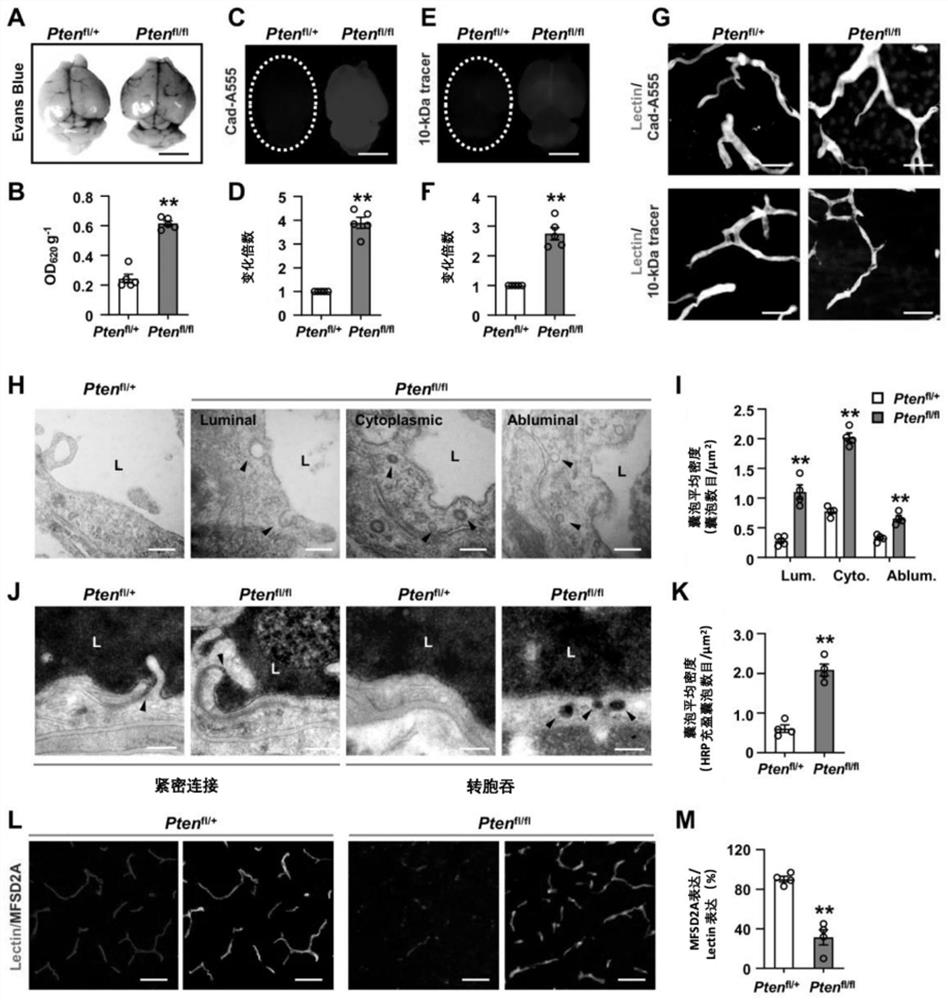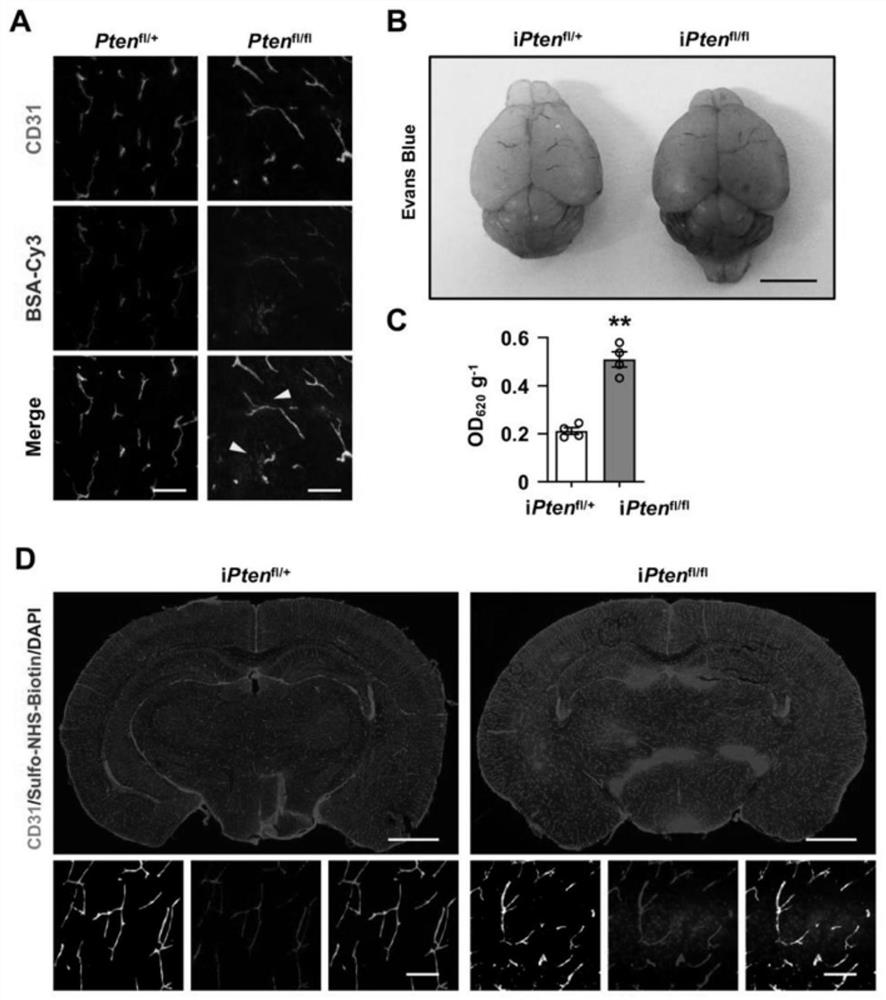Method for regulating and controlling blood brain barrier permeability and application of method for regulating and controlling blood brain barrier permeability
A blood-brain barrier and permeability technology, applied in the field of medical biology, can solve problems such as unclear and increased ubiquitination of Mfsd2a
- Summary
- Abstract
- Description
- Claims
- Application Information
AI Technical Summary
Problems solved by technology
Method used
Image
Examples
Embodiment 1
[0071] Example 1. Knocking out the PTEN gene in cerebral blood vessels promotes transcytosis and increases the permeability of the blood-brain barrier
[0072] 1.1 Preparation of PTEN knockout mice specific for cerebrovascular endothelial cells
[0073] 1.1.1 PTEN conditional gene targeting mice (PTEN fl / fl mouse) construction
[0074]PTEN is a dual lipid / protein phosphatase that dephosphorylates the lipid phosphatidylinositol (3,4,5)-triphosphate and inhibits Akt activity (Song et al., 2012). Mouse homologous phosphatase-tensin (PTEN) is a protein whose amino acid sequence is shown in GenBank Accession No.NP_038796 (Update Date 2021-01-03), mouse PTEN gene (wild-type allele, PTEN + / + ) includes 9 exons, and its genome sequence is the sequence shown in the 32734977-32803560th nucleotide of GenBank Accession No.NC_000085.7 (Update Date 2020-09-22), and the 32734977th nucleotide is recorded as is the first nucleotide of the PTEN gene, wherein, 32734977-32735824 is the first e...
Embodiment 2
[0168] Example 2. Overexpression of NEDD4-2 in brain ECs leads to impaired blood-brain barrier integrity
[0169] 2.1 Construction of NEDD4-2 overexpression vector pAAV-Myc-NEDD4-2 in brain ECs
[0170] In order to ectopically overexpress the E3 ubiquitin ligase NEDD4-2 gene of brain Ecs, the present invention adopts the restructured brain endothelial-specific AAV-BR1 (pAAV-EGFP) system to obtain the recombinant expression vector pAAV-Myc-NEDD4- 2 overexpress NEDD4-2 gene in brain endothelial cells, and construct the overexpression vector of tdTomato gene and tdTomato-2A-Mfsd2a gene at the same time: Myc-NEDD4-2 (SEQ ID No.3 in the sequence listing), and tdTomato, The tdTomato-2A-Mfsd2a gene is cloned into pAAV-EGFP (comprising the CAG promoter, EGFP gene and SV40 Poly-A sequence) (SEQ ID No.4 in the sequence listing), respectively generating pAAV-Myc-NEDD4-2 plasmid, and pAAV-tdTomato, pAAV-tdTomato-2A-Mfsd2a plasmid (SEQ ID No. 5 in the sequence listing).
[0171] 2.1.1 Co...
Embodiment 3
[0211] Example 3. Research on the mechanism of action of the PTEN / Akt / NEDD4-2 / Mfsd2a axis in the PTEN / Akt signaling pathway
[0212] 3.1 Knockout of PTEN gene in cerebral blood vessels promotes transcytosis
[0213] In order to solve the problem of how to destroy the integrity of the blood-brain barrier after knocking out the PTEN gene in the cerebral vascular endothelium, the present invention studies its influence on the tight junction and transcytosis of endothelial cells. Electron microscope observation showed that PTEN fl / fl and PTEN fl / + Endothelial cells of littermates had typical features of capillary endothelial cells and were surrounded by astrocytes and pericytes. Consistent with the findings of the above examples, the expression level and localization of tight junction protein in brain endothelial cells of PTEN knockout mice were normal. Electron microscopy failed to detect 8 PTENs of P60 fl / fl Mice and PTEN fl / + Any obvious abnormalities in the ultrastructure...
PUM
 Login to View More
Login to View More Abstract
Description
Claims
Application Information
 Login to View More
Login to View More - R&D
- Intellectual Property
- Life Sciences
- Materials
- Tech Scout
- Unparalleled Data Quality
- Higher Quality Content
- 60% Fewer Hallucinations
Browse by: Latest US Patents, China's latest patents, Technical Efficacy Thesaurus, Application Domain, Technology Topic, Popular Technical Reports.
© 2025 PatSnap. All rights reserved.Legal|Privacy policy|Modern Slavery Act Transparency Statement|Sitemap|About US| Contact US: help@patsnap.com



